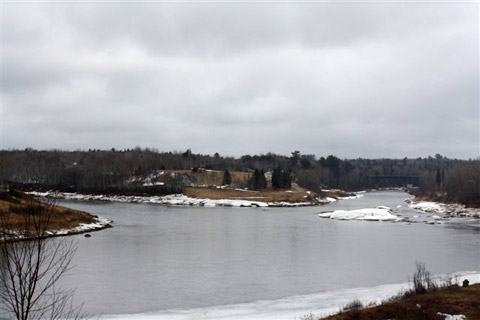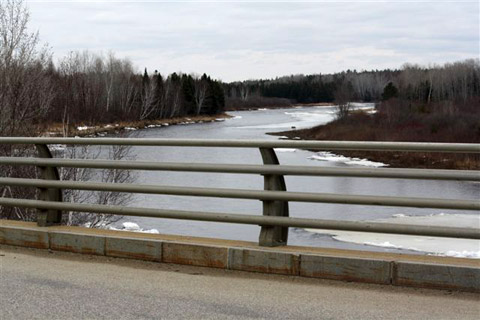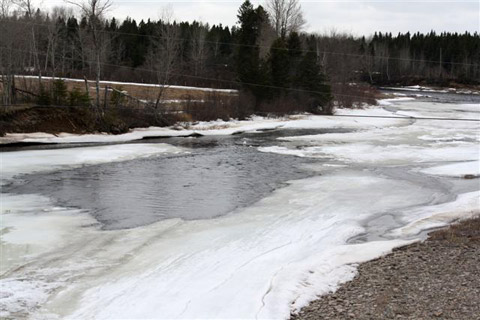Opening Day for Spring Salmon is Monday April 15, 2013, and thus far it looks as if a good portion of the system will have fishable waters for anglers. Dave Ingersoll and I took a drive on Tuesday of this week to check out ice conditions on the Northwest Miramichi, The Main Southwest and the Renous. We did find a considerable amount of open water on all three rivers.

W. W. Doak and Sons in Doaktown said the Main Southwest Miramichi was basically open from Boiestown down to the City of Miramichi. However, there was some ice lodged on bars here and there. The water was quite low for spring, and barring a good rain or fairly WARM TEMPERATURES, TRAVEL BY BOAT COULD BE TRICKY. They suggested that many anglers using boats will find they can only fish the stretch in which they launch. Some felt that it would be even difficult to get a boat through the Dr.’s Island area in Blackville. There was also a fair bit of open water on the Cains River and the Bartholomew River near Blackville also had a fair bit of open water. Above Boiestown, there was still ice in solid around Norrad’s Bridge through to the Hayesville area.
Herb Barry Sr. of Herb’s Fly Shop on the Station Road in Blackville agreed that running boats in his are was iffy and felt that a lot of anglers might be fishing from shoe due to low water levels unless things change before Monday.
Opening Day patterns for streamers included Renous River Specials, Golden Eagles, Black Ghosts, Mickey Finns and Maribou patterns.
George Routledge of George’s Fly Shop at the Mouth of Renous in Quarryville said the Renous was pretty well clear of ice except around the Manderville Farm area about half way between the mouth and the bailey bridge.
Workers at Debbie Norton of Upper Oxbow Outdoor Adventures on the Little Southwest Miramichi said the ice was still in at the Red Bank/Sunny Corner area, but was weak. A change in weather could move it. It was also in between Johnson’s Bridge and the Red Bank Bridge. There was still some ice in the tide-way between the Red Bank Bridge and Anderson Bridge on the NW Miramichi, but up-stream from the Anderson Bridge it was breaking up considerably.
So it looks positive for anglers to be able to be “on the water” in a fair bit of the entire system.

REMINDERS:
Anglers must use single barbless hooks or ones with the barb pinched back. So check your fly box to make sure all hooks are prepared before you hit the water. Putting on a barbed hook by mistake may could be very costly in terms of fines, loss of equipment and angling privileges.
Get your license at Service NB Offices (Remember they are closed Saturday and Sunday) or your local fly shop or convenience store that sells them. Only Crown Reserve licenses are available at DNR offices this year.
There area lot of deer around the rods this time of year, so take a bit more time and drive a bit slower to make sure you arrive and depart for home safely.
Don’t forget to show your support for our sponsors, because without them, this column would not be possible.
Providing quality gear for the outdoor enthusiast all year round, Pronature in Miramichi has you covered. Stop in to check out their rods, reels, tackle and gear.
Check out Deals 4 U in Miramichi for your grocery needs, and good Cuban cigars to celebrate getting back to the rivers.
Drop in to Bryant Freeman’s Eskape Anglers in Riverview to stock up on streamers for spring angling as well as any other equipment you may need such as a Redington Rod.
ANY FINANCIAL CONTRIBUTIONS TOWARD HELPING WITH THIS COLUMN ARE GREATLY APPRECIATED. Click here to donate now. A SPECIAL THANKS to all who made contributions last season.

PREPARATIONS FOR OPENING DAY
That long awaited April 15 is fast approaching. After a successful Dieppe Fly-Tying Forum, many anglers have the fever for opening day, and this year looks like almost every, if not all, rivers will be ready. So, it’s time to get ready.
First, buy a license. You don’t need to be getting ready the night before and suddenly realize “I don’t have my license”. Next, be sure to have at least one tag in your possession. Most anglers do not keep black salmon and therefore do not think they need to have a tag, but the law says that anglers must have a tag if angling for salmon.
With some time before opening day, it’s nice to get into the mood with a hands-on look at equipment. George Routledge of George’s Fly Shop in Renous had the following suggestions. First check the reel. Most probably have forgotten to look after it last fall when angling was over. Routledge suggested giving it a good cleaning and dusting, along with a coat of light oil. He prefers light heat resistant oil like 3-in1, Singer sewing machine oil or a gun-oil rather than grease, as grease tends to harden. This oiling should take place several times throughout the season for best results.
Next the fly line. For those new to angling for black salmon, a sinking line is recommended, as opposed to the floating line used during summer. Unlike bright salmon, blacks tend to rest in deeper water as they drop down, choosing slack water, eddies, and deeper holes out of the current.
For shore-fishing, Routledge suggested a fast sinking (no. 5 sink) for early fishing, and later in the season a no. 2 or 3. Sinking lines will range from $13.00 to $45.00 depending on brand and quality.
Old lines must be checked for cuts and cracks, and cleaned and greased with silicone. Check where it is tied to the backing to see if all is in good shape. Lacquer covering the joint must be smooth and uncracked. Backing should also be checked for rot from oil or fly dope. Failure could ruin a day on the river if it breaks on the first fish.
Routledge suggests 12 to 15 pound-test leader, averaging three to five feet in length. He recommends new leader each year, especially if one prefers no. 6 or 8. “For the price of a new leader, losing a big fish is not worth it. Not only the fish, but the story also gets away,” said Routledge.
The rod should be examined, paying attention to the guides. Make sure they’re tight and the lashing isn’t frayed. If so, repair them or take them to a tackle shop. Before putting a rod together, add oil or silicone so sections will come apart easily. A crude method is to rub the male end along the side of your nose. This will often be enough. Check the reel seat to make sure it is functioning and tight. You do not want it to plop into the water with a fish on. Waders should be examined for cracks and leaks with some goop applied where necessary.
Now’s the time to do some re-organizing. Put streamer flies into one box, hairwings in another, dryflies and bombers in another and maybe, if you’re like me, carrying more flies than I’ll ever use, the few most often used in another box.
Sharpen hooks. A dull hook may slip and gouge a fish you’re planning to release anyway. A whetstone or special sharpener will put hooks into top form. Pinching the barb or barbless hooks for Blacks is mandatory. It causes less harm to fish.
Check to see if new streamers are needed. Then buy them, or head for the tying bench. A few nights with a friend, a few stories (never lies, of course!) will certainly set the mood. Get or tie big streamers in the 5/0 and 3/0 ranges. Then make sure the streamer box goes back into the vest.
With the excitement of getting back onto the river, we might tend to be over anxious, forgetting the common sense needed for safe angling. One mistake can be too many given conditions and temperatures this time of year. Currents are extremely strong as rivers are flooded with spring run-off and ice, and the water is COLD. A dip means hypothermia in literally minutes. It may be too late for a second chance.
First, I’ll address “shore angling.” Although a lot of shore ice has gone, there is still some around. Many times spring ice will completely cover the shore after the river opens making it necessary to crawl over it. This can produce nasty falls. The ice can also be soft and give way causing twisted knees.
If one slips, he may end up in fast current and be gone, especially with heavy clothes on. Most shore anglers never think to wear a life jacket. Even if he manages to grab on to something, equipment may be lost as well.
Even if one does successfully navigate over bank ice, he has to still keep an eye on it. Melting may collapse the ice sending it sliding into the river behind you. If you aren’t careful it can trap you knocking you into the water.
Wading this time of year is very dangerous. Even what was familiar ground becomes strange in spring high current. One step too many can throw an angler off balance in heavy current, and getting over ice usually means there are no bushes handy enough to grab.
Even if the shore is clear and one knows the ground to be level, he still has to be checking up river for ice which may have slipped into the water. Of course, one should never venture forth alone. If anything happens, you are on your own.
Now for boats. Common sense should prevail. A stupid move could be deadly in spring water. First, make sure the “PLUG” for draining the boat is securely in place before putting the craft into the water.
The anchor should always be heavy enough to hold in strong current. A heavy chain link is recommended but attach it by a rope. Most do this, but some may try a cable or chain. If the boat is anchored and up-river ice suddenly comes down, there may be no time to pull anchor.
If ice hits the anchor rope, it will sink the boat and anglers will likely be caught under a floating raft of ice. Using a rope enables one to cut it in an emergency. Therefore, have a sharp knife HANDY.
Some boats use two anchors which most consider dangerous. Make sure the bow is pointing into the current when the anchor(s) is dropped. A side-ways boat is a sure invitation to flip.
Always follow the recommended number for the boat. Don’t cram five into a boat built for three. Be careful of having too much weight at the front of the boat when the anchor is dropped. When it grabs, the front will naturally take a dip. Too much weight in front may mean anglers taking a dip.
A bailing can on board is a smart idea, not only for when a leak occurs, but when heading up river at a pretty good clip, there’s often a lot of spray that accumulates in the boat. This will be enough to wet lunches, ruin cameras or other materials placed on the floor.
Every boat must also have at least an oar or paddle in case the motor quits. A pair of either is even better as one person trying to guide a boat in fast water may lead you in circles. A set pole to push off shore is also a good idea.
When starting the engine, make sure everyone is ready and seated. A sudden start can knock a person off balance. When moving around in the boat, be careful making certain not everyone moves in one direction at the same time. Have life jackets for each person and WEAR THEM.
Even a spare fuel can is not a bad idea. Sometimes travelling up and down the river you may hit heavier water than expected and use more fuel than anticipated. Always check and fill the tank before leaving. It is also wise to have an extra plug and plug wrench along with a few basic tools.
Should the motor fail, a tow rope makes life a lot easier should another angler offer help and to throw to someone overboard. A whistle and water-proof flash light are required items.
When approaching another boat, take a wide berth and slow down so as not to cause a wake which could rock another boat. If someone is anchored, don’t stop too close. When angling for spring salmon, many fishermen let out tremendous amounts of line and then reel in. You don’t want your line in someone else’s territory.
A neat idea for measuring the length of fish is to have a scale marked along the top sides of the boat. This way length can be taken quickly and the fish released, or better still the angler can gauge the length with a quick look with the fish still in the water. Some have a scale marked on the middle seat of the boat where the fish can be laid quickly and released. This saves time and fumbling for a measuring tape and often prevents a good tape from getting wet or bent. Remember, no salmon can be kept even in spring. Anything over 63 cm must go back.
A pocket journal is a good way to record a day’s fishing. It’s always nice to look back and know exactly who caught what. This can settle friendly arguments, should anyone’s imagination go adrift.
Dress warmly in layers and have a rain coat. You can always take it off, but without enough clothes, it can be a miserable day should a cool wind come up. A thermos of coffee or tea can be a welcome treat. Don’t forget to have the trailer in good working order (tires, lights etc.) inspected and registered.
Don’t forget your streamer flies.
So as Monday approaches, common sense and a few preparations can make for an enjoyable day “on the water.”

STRIPED BASS UPDATE
There has been no official word of what or if there will be a season for stripers this year. However, it looks as if DFO will have some sort of Hook & Release season and a period in which some bass may be retained. For the Gulf Region, an August retention period is suggested, but Miramichi anglers want that period to be in May for our area as bass have spawned and migrated by then.
DFO met with selected members of the angling community several times in the past few weeks with discussion going back and forth from both sides.
Originally DFO proposed a closure of all angling in the bass spawning and staging areas from the new bridge in Miramichi to the Red Bank Bridge and approximately near the railroad bridge on the Main Southwest Miramichi. This was deemed unacceptable to MSA President Mark Hambrook and members of the committee selected to meet with DFO.
After several discussions and a public meeting last Sunday where close to 300 people showed up to express their displeasure with the current numbers of bass in the system and no angling allowed, DFO seemed to be open to a comprise. However, nothing is official as yet. But people got the impression that the staging area (Strawberry Marsh and Nelson side up to the mill area) (give or take) may be open to angling for hook and release throughout the regular season to mid to late October. As well there may be a two week or so retention period where anglers may keep a bass a day.
Points of strong contention from both sides of the issue are as follows: DFO definitely want to close the spawning area approximately from the cement plant to the Mill Stream area of the Northwest Miramichi. They stressed finding a “balance” between keeping the stocks up while at the same time allowing a recreational fishery, with possible retention.
From the other side, people felt that there was no reason to try to protect the spawning area as anglers have been fishing there for quite a few years, and yet the bass numbers have increased expediently. DFO suggested they needed a spawning number of about 30,000 while the estimated number of bass is about 250,000.
People are concerned that these very high numbers are endangering the salmon populations as the bass will feed on the out-going smolts, which hampers the future of salmon stocks as well as smelt populations, gaspereaux, shad and even very small lobsters.
Not only eating the smolt hampers the salmon, but spring salmon also feed on smelt as they prepare to leave the estuary, needing this food source for energy for their return to the ocean. As well, the above mentioned species (smelts, gaspereaux and shad) had very low harvest numbers last summer and this winter.
Hambrook speculated that if each bass in the system ate only one smolt, a year’s run could be decimated. So he and many others wanted no closure and wanted an open season in May where there were no restrictions. If research after this season pointed to a stricter control, perhaps that could be considered next year in co-operation with DFO.
Over 200 individually signed letters were sent to the Honourable Keith Ashfield, Minister of Fisheries. We await a decision, and hopefully sooner than later as another season is upon us!
Thought for the Week: “Be patient and calm – for no one can catch fish in anger”…. Herbert Hoover
Until next week
TIGHT LINES
DOUG
